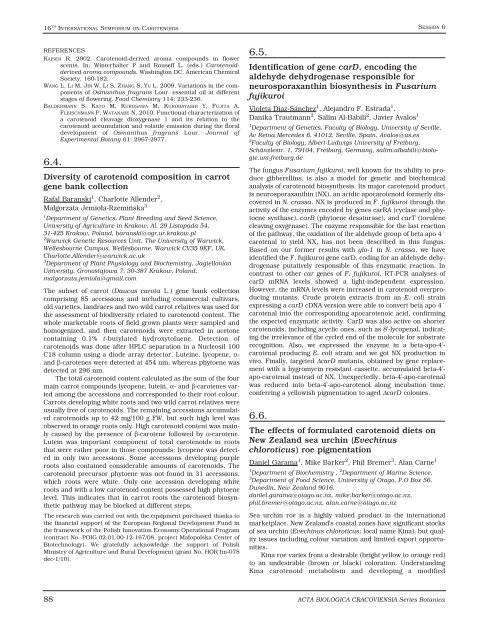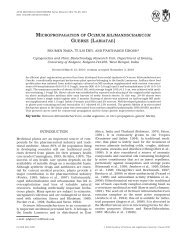ACTA BIOLOGICA CRACOVIENSIA
ACTA BIOLOGICA CRACOVIENSIA
ACTA BIOLOGICA CRACOVIENSIA
Create successful ePaper yourself
Turn your PDF publications into a flip-book with our unique Google optimized e-Paper software.
16 TH INTERNATIONAL SYMPOSIUM ON CAROTENOIDS<br />
REFERENCES<br />
KAISER R. 2002. Carotenoid-derived aroma compounds in flower<br />
scents. In: Winterhalter P and Rouseff L. (eds.) Carotenoidderived<br />
aroma compounds. Washington DC, American Chemical<br />
Society, 160-182.<br />
WANG L, LI M, JIN W, LI S, ZHANG S, YU L. 2009. Variations in the components<br />
of Osmanthus fragrans Lour. essential oil at different<br />
stages of flowering. Food Chemistry 114: 233-236.<br />
BALDERMANN S, KATO M, KUROSAWA M, KUROBAYASHI Y, FUJITA A,<br />
FLEISCHMANN P, WATANABE N. 2010. Functional characterization of<br />
a carotenoid cleavage dioxygenase 1 and its relation to the<br />
carotenoid accumulation and volatile emission during the floral<br />
development of Osmanthus fragrans Lour. Journal of<br />
Experimental Botany 61: 2967-2977.<br />
6.4.<br />
Diversity of carotenoid composition in carrot<br />
gene bank collection<br />
Rafal Baranski 1 , Charlotte Allender 2 ,<br />
Małgorzata Jemioła-Rzemińska 3<br />
1 Department of Genetics, Plant Breeding and Seed Science,<br />
University of Agriculture in Krakow, Al. 29 Listopada 54,<br />
31-425 Krakow, Poland, baranski@ogr.ur.krakow.pl<br />
2 Warwick Genetic Resources Unit, The University of Warwick,<br />
Wellesbourne Campus, Wellesbourne, Warwick CV35 9EF, UK,<br />
Charlotte.Allender@warwick.ac.uk<br />
3 Department of Plant Physiology and Biochemistry, Jagiellonian<br />
University, Gronostajowa 7, 30-387 Krakow, Poland,<br />
malgorzata.jemiola@gmail.com<br />
The subset of carrot (Daucus carota L.) gene bank collection<br />
comprising 85 accessions and including commercial cultivars,<br />
old varieties, landraces and two wild carrot relatives was used for<br />
the assessment of biodiversity related to carotenoid content. The<br />
whole marketable roots of field grown plants were sampled and<br />
homogenized, and then carotenoids were extracted in acetone<br />
containing 0.1% t-butylated hydroxytoluene. Detection of<br />
carotenoids was done after HPLC separation in a Nucleosil 100<br />
C18 column using a diode array detector. Luteine, lycopene, αand<br />
β-carotenes were detected at 454 nm, whereas phytoene was<br />
detected at 296 nm.<br />
The total carotenoid content calculated as the sum of the four<br />
main carrot compounds lycopene, lutein, α- and β-carotenes varied<br />
among the accessions and corresponded to their root colour.<br />
Carrots developing white roots and two wild carrot relatives were<br />
usually free of carotenoids. The remaining accessions accumulated<br />
carotenoids up to 42 mg/100 g FW, but such high level was<br />
observed in orange roots only. High carotenoid content was mainly<br />
caused by the presence of β-carotene followed by α-carotene.<br />
Lutein was important component of total carotenoids in roots<br />
that were rather poor in those compounds; lycopene was detected<br />
in only two accessions. Some accessions developing purple<br />
roots also contained considerable amounts of carotenoids. The<br />
carotenoid precursor phytoene was not found in 31 accessions,<br />
which roots were white. Only one accession developing white<br />
roots and with a low carotenoid content possessed high phytoene<br />
level. This indicates that in carrot roots the carotenoid biosynthetic<br />
pathway may be blocked at different steps.<br />
The research was carried out with the equipment purchased thanks to<br />
the financial support of the European Regional Development Fund in<br />
the framework of the Polish Innovation Economy Operational Program<br />
(contract No. POIG.02.01.00-12-167/08, project Małopolska Center of<br />
Biotechnology). We gratefully acknowledge the support of Polish<br />
Ministry of Agriculture and Rural Development (grant No. HOR hn-078<br />
dec-1/10).<br />
6.5.<br />
Identification of gene carD, encoding the<br />
aldehyde dehydrogenase responsible for<br />
neurosporaxanthin biosynthesis in Fusarium<br />
fujikuroi<br />
Violeta Díaz-Sánchez1 , Alejandro F. Estrada1 ,<br />
Danika Trautmann2 , Salim Al-Babili2 , Javier Avalos1 1Department of Genetics, Faculty of Biology, University of Seville,<br />
Av Reina Mercedes 6, 41012, Seville, Spain, Avalos@us.es<br />
2Faculty of Biology, Albert-Ludwigs University of Freiburg,<br />
Schänzlestr. 1, 79104, Freiburg, Germany, salim.albabili@biologie.uni-freiburg.de<br />
The fungus Fusarium fujikuroi, well known for its ability to produce<br />
gibberellins, is also a model for genetic and biochemical<br />
analysis of carotenoid biosynthesis. Its major carotenoid product<br />
is neurosporaxanthin (NX), an acidic apocarotenoid formerly discovered<br />
in N. crassa. NX is produced in F. fujikuroi through the<br />
activity of the enzymes encoded by genes carRA (cyclase and phytoene<br />
synthase), carB (phytoene desaturase), and carT (torulene<br />
cleaving oxygenase). The enzyme responsible for the last reaction<br />
of the pathway, the oxidation of the aldehyde group of beta apo 4´<br />
carotenal to yield NX, has not been described in this fungus.<br />
Based on our former results with ylo-1 in N. crassa, we have<br />
identified the F. fujikuroi gene carD, coding for an aldehyde dehydrogenase<br />
putatively responsible of this enzymatic reaction. In<br />
contrast to other car genes of F. fujikuroi, RT-PCR analyses of<br />
carD mRNA levels showed a light-independent expression.<br />
However, the mRNA levels were increased in carotenoid overproducing<br />
mutants. Crude protein extracts from an E. coli strain<br />
expressing a carD cDNA version were able to convert beta apo 4´<br />
carotenal into the corresponding apocarotenoic acid, confirming<br />
the expected enzymatic activity. CarD was also active on shorter<br />
carotenoids, including acyclic ones, such as 8'-lycopenal, indicating<br />
the irrelevance of the cycled end of the molecule for substrate<br />
recognition. Also, we expressed the enzyme in a beta-apo-4'carotenal<br />
producing E. coli strain and we got NX production in<br />
vivo. Finally, targeted ΔcarD mutants, obtained by gene replacement<br />
with a hygromycin resistant cassette, accumulated beta-4'apo-carotenal<br />
instead of NX. Unexpectedly, beta-4'-apo-carotenal<br />
was reduced into beta-4'-apo-carotenol along incubation time,<br />
conferring a yellowish pigmentation to aged ΔcarD colonies.<br />
6.6.<br />
SESSION 6<br />
The effects of formulated carotenoid diets on<br />
New Zealand sea urchin (Evechinus<br />
chloroticus) roe pigmentation<br />
Daniel Garama 1 , Mike Barker 2 , Phil Bremer 3 , Alan Carne 1<br />
1 Department of Biochemistry , 2 Department of Marine Science,<br />
3 Department of Food Science, University of Otago, P.O Box 56,<br />
Dunedin, New Zealand 9016,<br />
daniel.garama@otago.ac.nz, mike.barker@otago.ac.nz,<br />
phil.bremer@otago.ac.nz, alan.carne@otago.ac.nz<br />
Sea urchin roe is a highly valued product in the international<br />
marketplace. New Zealand's coastal zones have significant stocks<br />
of sea urchin (Evechinus chloroticus; local name Kina), but quality<br />
issues including colour variation and limited export opportunities.<br />
Kina roe varies from a desirable (bright yellow to orange red)<br />
to an undesirable (brown or black) coloration. Understanding<br />
Kina carotenoid metabolism and developing a modified<br />
88 <strong>ACTA</strong> <strong>BIOLOGICA</strong> <strong>CRACOVIENSIA</strong> Series Botanica












